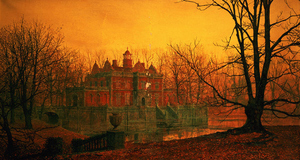Ghosts of Romanticism in Neil Gaiman's Children's Fiction
By
2017, Vol. 9 No. 03 | pg. 2/2 | « According to Freud, ‘intellectual uncertainty’ is a key ingredient to produce uncanniness, and Bod until this experience was a reluctant learner. He did not appreciate Miss. Lupescu’s teaching methods and refused to arm himself with vital knowledge, which would have helped him navigate Ghulheim. Gaiman used this journey with the ghouls as a pivotal point in the story. Bod upon encountering Uncanny becomes a more willing pupil. In Coraline, Gaiman demonstrates how his heroine, upon stepping into what she thought was an empty flat is immediately hit with this feeling of Uncanny. “There’s something very familiar about this. It’s the same carpet that we have in our flat” (Gaiman, “Coraline” 30). As she explores this other world she realizes that everything looked “exactly the same from the outside, or almost exactly the same” (Gaiman, “Coraline” 39). Although initially novel, this experience is actually frightening that Coraline “put her hand in her pocket and thought about it. Her hand touched the stone with the hole in it” (Gaiman, “Coraline” 49). Without the stone talisman to orient her, she would have been lost to the illusion. In the case of Lucy, we find that in addition to the disorientation in space there is the second factor that adds to the uncanniness. “A particularly favorable condition for awakening uncanny feelings is created when there is intellectual uncertainty whether an object is alive or not, and when an inanimate object becomes too much like an animate one” (Freud 424). Pig-puppet is such an object, a significant part of Lucy’s life, the one she truly trusts and has meaningful conversations with. In fact, it was to rescue Pig-puppet that Lucy, “Quick as the flick of the wing of a bat” slipped into the wall. She crept through the house on the inside, through the downstairs up the middle and into the wall of her bedroom...pushed open the picture that hung over her bed and she climbed down carefully, quietly and she picked up her pig-puppet from the floor (Gaiman, “The Wolves in the Walls”). The first encounter with their own unconscious, although frightening sets the protagonists on a path to knowledge. Gothic fiction is fascinated with the unconscious and uses location as its metaphor to convey the “depths and inaccessibility of the unconscious” (Nadal). As Punter says,“the uncanny comes to remind us that there is no obvious beginning, to life or to thought, that we are composed of prior traces, some of them available for conscious memory but most of them sunk in a primal past” (Nadal). Gothic settings in graveyards, faraway castles, or ruins using symbols of crypts, tombs, sepulchers, bones of the dead, communicate that every location has traces of history and the movement of the psyche between the real and imaginary space is aided by transitions in physical space. Wolfreys argues that this method of chorographical articulation helps in unearthing forgotten memories associated with a place, and a graphic novel is “particularly well suited to respond to the darker aspects of the city” by employing “locations or buildings as the principal structuring devices” (Wolfreys) for narratives. Neil Gaiman employs some of the techniques outlined, in the three works to create shifting boundaries between the real and imaginary. Whether the location is a graveyard, an old English mansion converted into flats, or just a rickety house with wolves living in the walls, Gaiman has a knack for setting his stories in locations that seem rich with their own history and become important characters in his works. Each location in the books supports what appears to be parallel universes and interesting things happen when the protagonist travels across these spaces. In The Wolves in the Walls, although Lucy’s brother informs her that “there are no wolves in this part of the world” he is proven wrong as they did exist within the walls of their home, and so do elephants. Even the Queen of Melanesia seems to have an interest in Lucy’s garden. The identity of their home is therefore formed by multiple inhabitants, each with the “potential to call up forgotten memories” (Wolfreys). This concept of simultaneity and forgotten memories is further explored in Coraline which is set in a “very old house.” “Coraline’s family didn’t own all of the house - it was too big for that. Instead they owned part of it. There were other people who lived in the old house” (Gaiman, “Coraline” 2). Right there, the reader is made aware that this house which has been transformed into a multi-resident dwelling, holds a number of simultaneous memories just by being a shared location. Gaiman takes this concept one step further when he introduces us to the ‘Other family’ who have buttons for eyes. Sharing what appears to be the same space as Coraline’s family they exist in a parallel universe in a different reality. Inside this nested narrative, there exists one more layer of forgotten narrative that belongs to the three ghostly children that Coraline encounters. The old house also contains the memories of the three children who inform Coraline that “we keep our memories longer than our name. I remember my governess, and the morning sun, and all the tulips bobbing in the breeze. But I have forgotten the name of the Governess and of the tulips too” (Gaiman, “Coraline” 92). The Graveyard Book is in many ways a traditional Gothic fairy tale. Set in a graveyard, filled with ghosts, ghouls, vampires, werewolves and one human who is a ‘nobody’, the location, its inhabitants and their memories are critical to the narrative. Nobody Owens (Bod for short) has no personal memories or history of his own, on account of his parents being murdered when he was still a toddler. Even his name is unknown to him. His survival and his ultimate revenge instead depended on a thorough understanding of his environment and knowing the long forgotten history and memories of the inhabitants of the graveyard. By evoking hidden memories, all three works in the tradition of Gothic Fairy tales, show traces of a forgotten past, which affects the present fates of the protagonists and their visions for the future. This is one of the reasons that fairy tales “transcend time and place” (Zipes 190). They deal with complex social realities by using simple motifs, one of which is a location in an enchanted, faraway or haunted place. Children have a number of questions about who they are, where they come from, what their future is going to be and when coupled with their natural curiosity about their world, they have a rich internal life that is not often paid attention to by the adults around them. Fairy tales with children as heroes have strived to answer some of these questions and Gaiman’s works are no different. Bloch, according to Zipes claims that “ the appeal of the fairy tale no matter what its form may be, is boundless because its tendency or tendentiousness indicate the possibility for change and the fulfillment of dreams” (Zipes 190). The three heroes, in true fairytale fashion are each accorded special powers and/or special tools. Lucy has ‘super-hearing’, Coraline has a stone with a hole, Bod has the “Freedom of the graveyard” and abilities to dream walk and fade and just as “fairy tale heroes perceive how to take advantage of all kinds of magical or wish instruments that benefit their struggles” (Zipes 192), the three of them use their powers to fulfill their quests and save or avenge their families. The Romantic period fostered debate around society and childhood. Prior to that, children were not considered to have a distinct identity and were mere extensions of the adults around them. Poets like William Blake and Wordsworth were one of the first to recognize and idealize childhood by associating children with nature and innocence, almost as a contrast to the commoditization that was happening as many of them were driven to work in factories. Children’s literature emerged during this time as literacy rates started to rise among children. The Romantics were also concerned with a common bias at that time, the one in “favor of economic growth and scientific progress over creativity and humanitarian concerns” (Black 760). They responded by emphasizing the importance of imagination, spending time in nature, questioning authorities and social structures. Although two hundred years have gone by and many of the hurdles faced by children back then have been overcome (at least in the West), today’s children also face very many pressures. Everyday in the media we hear from experts who claim that modern day pressures is making children grow up too fast. “Childhood is being eroded by a “relentless diet” of advertising, addictive computer games, test-driven education and poor childcare, a powerful lobby of more than 200 experts warns today” screams one headlines from The Telegraph. Another study from the University of Maryland shows that peer pressure starts in childhood, not with teens as commonly believed. The Pew Research Center, which studies American families highlights screen time as one of the main concerns of parents. It then comes as no surprise that a writer like Neil Gaiman who is concerned with lives of children, the arts, and imagination is inspired by the Romantics. Lucy, Coraline and Bod are fictional children living in a fantasy world and face difficulties which appear to have no ground in reality. Just as the Grimms “turned to the ancient folks and fairy tales in an endeavor to fill something that was missing in their lives” (Zipes 194), these stories hold up a mirror to the longings of childhood and shine the spotlight on what is missing. The fictional children in Gaiman’s stories experience a lot of pressure, albeit different ones from those faced by ‘real’ children and are indeed forced to grow up too fast. However, in keeping with the spirit of romanticism they also show what happens when adults trust a child’s imagination, creativity and intuition, which are as valuable as rational thinking, if not more. In the end the stories are about commonplace fears that children experience - how can they remain unique and still fit in, how do they get the attention of their parents, how do they find a voice, how to deal with fears and in the process discover their true identities. Yes, the stories are scary, but so is the real world and Gaiman believes that “fiction is a way of coping with the poison of the world in a way that lets us survive it” (Gaiman, “A View from the Cheap seats”). Gaiman's stories invite the readers to make meaning together. How does Lucy deal with the elephants? Did Coraline’s parents know that it was their daughter who rescued them? Will Bod survive in the outside world? While Gaiman leaves his readers with hope, he allows them to derive their own conclusions and in that process take control of the reading process. Although so many things are out of control of children in the real world, escapist fiction of which Gothic fiction was the precursor, “opens a door, shows the sunlight, gives you a place to go where you are in control, are with people you want to be with” (Gaiman, “A View from the Cheap Seats”). Accepting the Newberry Award for Children’s Literature for The Graveyard Book, Gaiman concluded, “we who make stories know that we tell lies for a living. But they are good lies that say true things, and we owe it to our readers to build them as best as we can” (Gaiman, “A View from the Cheap Seats”). Truth can be daunting to children, but truth is life affirming and children need to hear it even if it is packaged in fictional stories, which explains why Gothic Fairy Tales have become pervasive, everlasting and continue to inspire Neil Gaiman’s children’s fiction even today. ReferencesAusten, Jane. Northanger Abbey. Project Gutenberg. N.p. N.d. Web. 30 December 2016 Black, Joseph. The Broadview Anthology of British Literature. The Age of Romanticism. 2nd ed. Vol 4. Peterborough, Ontario: Broadview Press, 2010. Print. Campbell, Joseph. The Hero with a Thousand Faces. Novato, CA: New World Library, 2008. Print. “Childhood being eroded by modern life, experts warn.” The Telegraph. n.d.Web.01 Jan. 2017 Freud, Sigmund. "The Uncanny." Literary Theory: An Anthology. 2nd ed. Malden: Blackwell, 2004. N. pag. Print. Gaiman, Neil and Russell, Craig. Coraline. New York, NY: HarperCollins Children’s Books, 2003. Print. Gaiman, Neil. The Graveyard Book. New York: HarperCollins E-Books, 2008. Digital. Gaiman, Neil. The View from the Cheap Seats: Selected Nonfiction. New York, NY: William Morrow, an Imprint of HarperCollins, 2016. Digital. Gaiman, Neil. The Wolves in the Walls. New York, NY: HarperCollins Children’s Books, 2003. Print. Gamer, Michael. Romanticism and the Gothic: Genre, Reception, and Canon Formation. Cambridge: Cambridge UP, 2000. Print. Grimm, Jacob Ludwig Carl, and Wilhelm Carl Grimm. The Complete Grimm's Fairy Tales. 2016 ed. New York: Chartwell, 2016. Print. Lacan, Jacques, and Michael Ryan. "The Mirror Stage as Formative of the Function of the I as Revealed in Psychoanalytic Experience." Literary Theory: An Anthology. Ed. Julie Rivkin. 2nd ed. Malden: Blackwell, 2004. N. pag. Print. Nadal, Marita. "Trauma And The Uncanny In Edgar Allan Poe’S “Ligeia” And “The Fall Of The House Of Usher.”" Edgar Allan Poe Review 17.2 (2016): 178-192. Humanities International Complete. Web. 25 Dec. 2016. “Peer Pressure Starts in Childhood, Not with Teens.” University of Maryland. N.p., n.d. Web. 01 Jan 2017 Rudd, David. "An Eye For An I: Neil Gaiman’S Coraline And Questions Of Identity." Children's Literature In Education 39.3 (2008): 159-168. Humanities International Complete. Web. 12 Nov. 2016. Schäfer, Martin. "The Rise And Fall Of Antiutopia: Utopia, Gothic Romance, Dystopia." Science Fiction Studies 6.3 (1979): 287-295. Humanities International Complete. Web. 2 Nov. 2016. Wolfreys, Julian. "ImageTexT: Interdisciplinary Comics Studies." London Khorographic. N.p., n.d. Web. 20 Nov. 2016. Zipes, Jack. Grimm Legacies. New York, NY: Routledge, 2001. Print. Zipes, Jack. Preface. Sticks and Stones. Princeton, NJ: Princeton University Press 2015. Print. Suggested Reading from Inquiries Journal
Inquiries Journal provides undergraduate and graduate students around the world a platform for the wide dissemination of academic work over a range of core disciplines. Representing the work of students from hundreds of institutions around the globe, Inquiries Journal's large database of academic articles is completely free. Learn more | Blog | Submit Latest in Literature |


















